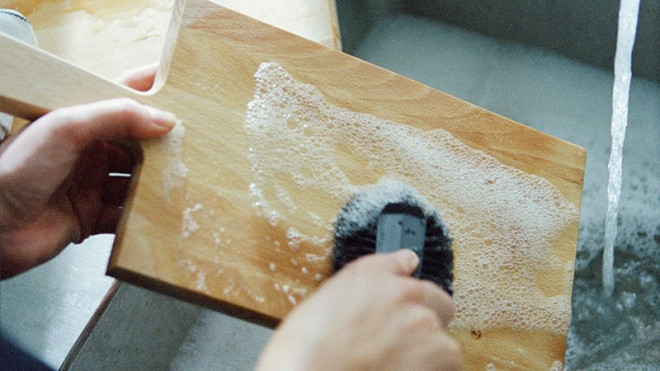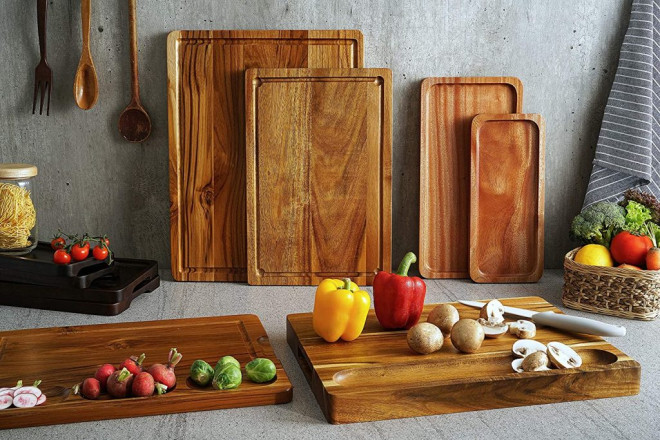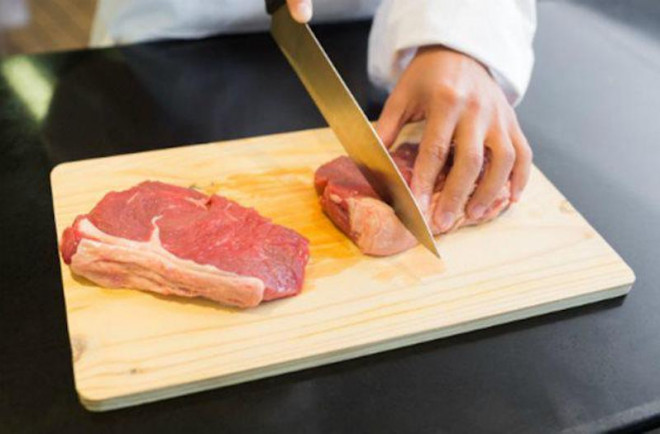4 steps to clean cutting boards to avoid poisoning
Food poisoning is not only caused by food, but also by food preparation tools. Whether wooden cutting boards, glass cutting boards or plastic cutting boards, if not cleaned properly, it can be a place for bacteria that cause food poisoning.
Each family should use separate chopping boards for raw food and separate chopping boards for cooked food. In case you cannot use two separate cutting boards, you can still use one but need to clean it after each use.
Here are 4 steps to help clean cutting boards, avoid poisoning:
Food poisoning is not only caused by food, but also by food preparation tools.
Step 1: Wash cutting board with hot water and soap
If using the same cutting board for both raw and cooked meat, you should thoroughly wash and disinfect the cutting board after each use. However, you should remember that using separate cutting boards for different purposes will help minimize food poisoning.
If after slicing raw food and then use a wooden cutting board to cut cooked food, washing the cutting board between each use is the best way to reduce bacteria on the cutting board surface and avoid bacterial cross-contamination.
Whether it’s a wooden cutting board, a glass cutting board or a plastic cutting board, you should clean it after each use. First clean the cutting board surface with hot water and soap to remove food particles and bacteria, then rinse with water to remove soap residue.

Wash cutting boards with hot water and soap
Step 2: Dry the cutting board in the air
After washing, dry the cutting board with a clean cloth and then stand or hang the cutting board in the air to dry naturally. Note that the wipes need to be clean. If the towel is not clean, there is a potential risk of bacterial infection on the cutting board surface.
If you dry the cutting board on a flat surface, with a wooden cutting board, one side of the cutting board may warp. You should let the cutting board dry completely before moving on to the next disinfecting step.

Let the cutting board dry
Step 3: Disinfect cutting boards
Studies show that, depending on the type of wood used to make the cutting board, the texture, porosity and ability of each wood to absorb water will contain some specific types of bacteria. It is very important to disinfect cutting boards to reduce the amount of bacteria on the cutting board surface as well as reduce odors.
Washing the cutting board with dish soap may not be effective. Studies show that lactic acid-containing drinks such as lemon juice or apple cider vinegar can help reduce food poisoning bacteria on cutting boards.
The cutting board should be disinfected with the following formula: 15ml of cleaning solution with 4.5 liters of water or 5ml of cleaning solution with 950ml of water.
Here’s how to disinfect a wooden cutting board:
Scrub the wooden surface of the cutting board with a piece of lemon or spray the disinfectant you prepared on the surface of the cutting board. Leave to soak for 1-5 minutes. Rinse with water and let air dry as in step 2. Recommended Disinfect cutting boards at least once a week.

Lemon juice or apple cider vinegar can help reduce food poisoning bacteria on cutting boards.
Step 4: Maintain the cutting board with oil
Do not immerse the cutting board in water. Wood cutting boards are very porous and can absorb water when immersed in water, leading to cracks and reduced service life.
Do not put the cutting board in the dishwasher unless it is labeled as dishwasher safe. Many studies show that dishwashers can cross-contaminate bacteria from cutting boards to dishes.
After a period of use, wooden cutting boards are often prone to cracking, breaking or breaking. You should try to maintain the cutting board periodically is the best way to retain moisture and prolong the use of the cutting board. You can use mineral oils like liquid paraffin or maple oil.
Apply a layer of mineral oil to the surface of a clean, dry cutting board
Use a small paintbrush or towel to apply the oil until the cutting board is damp
Soak the cutting board overnight or for several hours before using it.
For best results, service the cutting board once a month.
Do not use ordinary cooking oil to maintain the cutting board as it can cause rot and lead to an unpleasant odor
Do not use a wooden cutting board that has been broken or cracked because the crevices are difficult to clean. Cracks are a hiding place for bacteria and can contribute to food poisoning. It is best to replace the cutting board with a new one immediately.
at Blogtuan.info – Source: 24h.com.vn – Read the original article here





